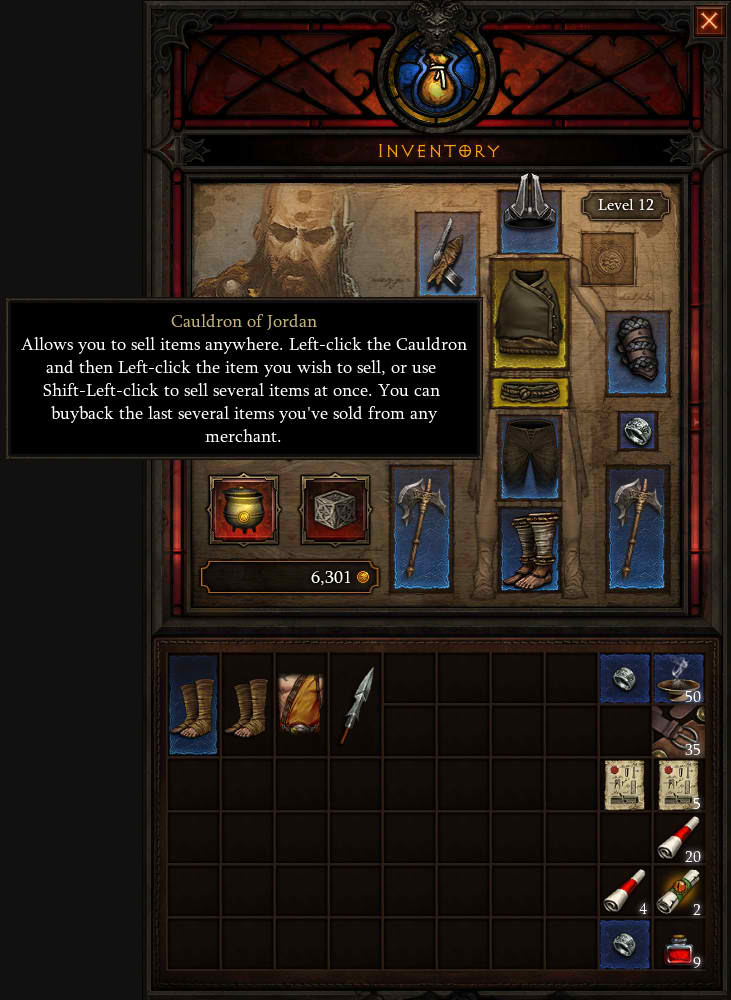
Original Title: Destroying Items… With Care
Facing down the forces of the Burning Hells is a dirty job, but somebody’s gotta do it. The good news is that the rewards for dispatching Diablo’s minions are rich, as the vanquished legions of the foul fiends will shower you in gold, gems, and loot. Every item you grab will present an intriguing choice, and in Diablo III you’ll have several tools that will help you get the most out of your treasure.
Cauldron of Jordan
Shortly after you begin your adventure, you’ll be provided with a useful little artifact: the Cauldron of Jordan. The cauldron allows you to skip trekking back to town when the time comes to sell your loot. After you obtain the Cauldron, you can reduce virtually any item in your inventory to gold, just as if you had sold it to a vendor. Gold can do a lot of things for you in Diablo III, from purchasing artisan services to repairing your damaged gear to buying shared stash slots. There’s more than one way to get value from loot though, which brings us to the other handy tool you’ll have at your disposal.
Nephalem Cube
The Nephalem Cube is another very helpful item that you’ll encounter over the course of your adventure. It works just like the Cauldron of Jordan, but with an important difference. When you click the Nephalem Cube it allows you to salvage crafting materials from your unwanted weapons, armor, rings, runes, and amulets. The process destroys the original item but yields a variety of materials that grow more powerful as increasingly rare items are salvaged. Thus, common items yield common crafting materials, but more rare and valuable items will yield potent mystical substances that can be used to create correspondingly mighty items and enhancements. You’ll want to keep a well-stocked hoard of crafting materials, because there’s great potential in those salvaged scraps.
Crafting
Delving into the Diablo III crafting system can be quite rewarding. You’ll encounter three artisans on your journey: the Blacksmith, Jeweler, and Mystic. These crafters of fine magical items and effects will help you make brand new armor and weapons, add powerful enhancements to your existing armor and weapons, or carve additional gem sockets into your gear.
Each of your artisans only has limited know-how initially, but with the investment of some gold, crafting materials, and Pages of Training looted on your adventure, you can improve their skills to gain access to more (and more powerful) recipes. A few recipes can be found on the corpses of monsters or in eerie ruins as well, but your artisan may need to attain greater skills before they can be learned. Artisans also don’t work for free. Crafting some of the most fearsome items and enhancements Sanctuary has ever seen doesn’t come cheap: the better the item or enhancement, the rarer the components you’ll need, and the more expensive it will be to achieve the finished product. That means it will pay great dividends to ensure that you have a steady stream of gold and salvaged materials flowing into your stash so you can reap the benefits of your artisans’ ever increasing potential.
Decisions, decisions
Imagine finding a truly powerful artifact with just the right mix of stats. You wouldn’t want to toss such a rare treasure into the Cauldron of Jordan or callously tear it apart with the Nephalem Cube. Instead, such a relic might better serve your hero directly in your crusade against diabolical hordes… or, perhaps you could provide it to another hero in need by selling it on the Auction House, trading it with a friend, or giving it to one of your other characters via the shared stash.
Every item you pick up over the course of your adventure in Sanctuary will present you with choices. Do you keep it? Salvage it? Auction it off? Give it away? With each new treasure you discover, only you can decide the best course of action.




